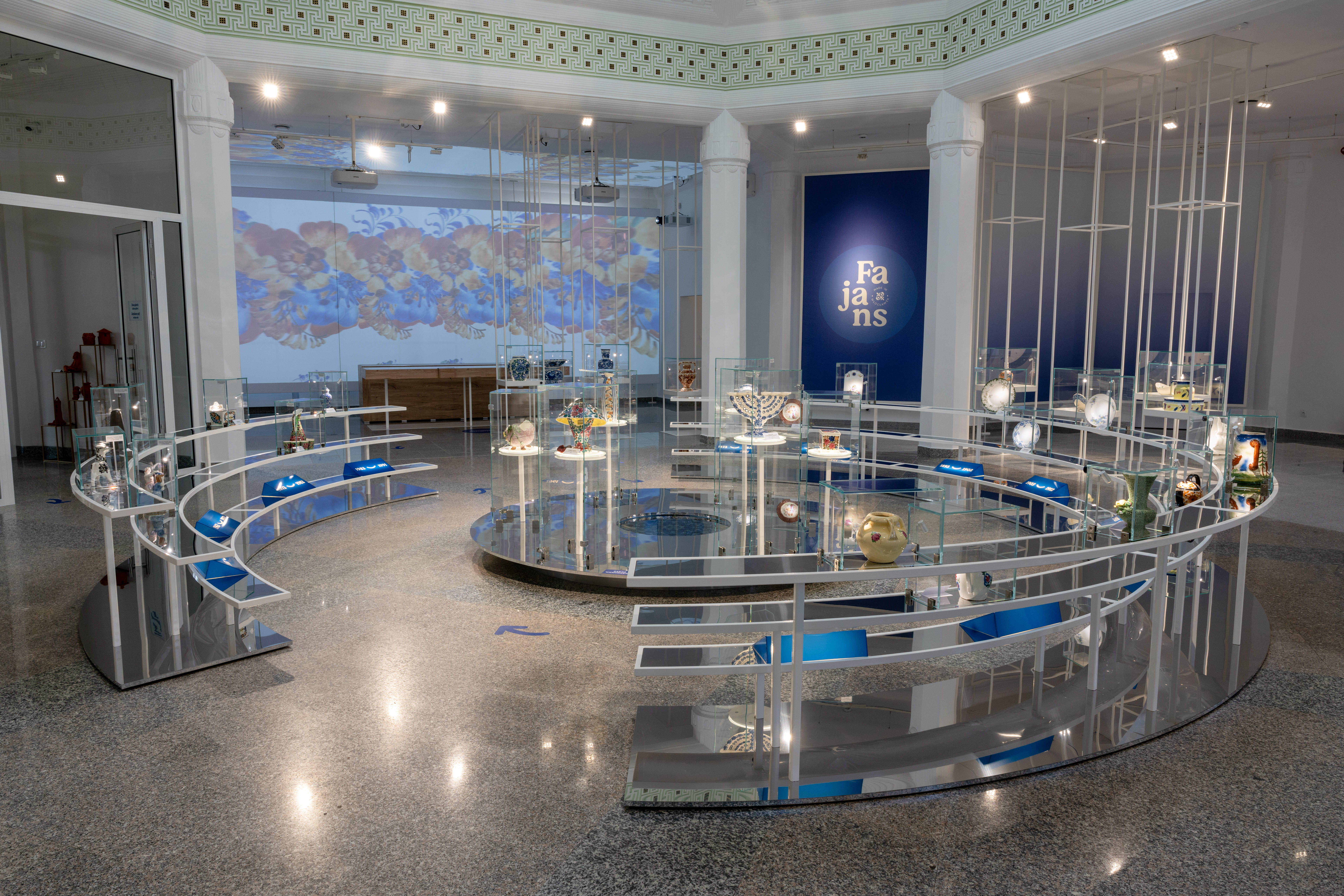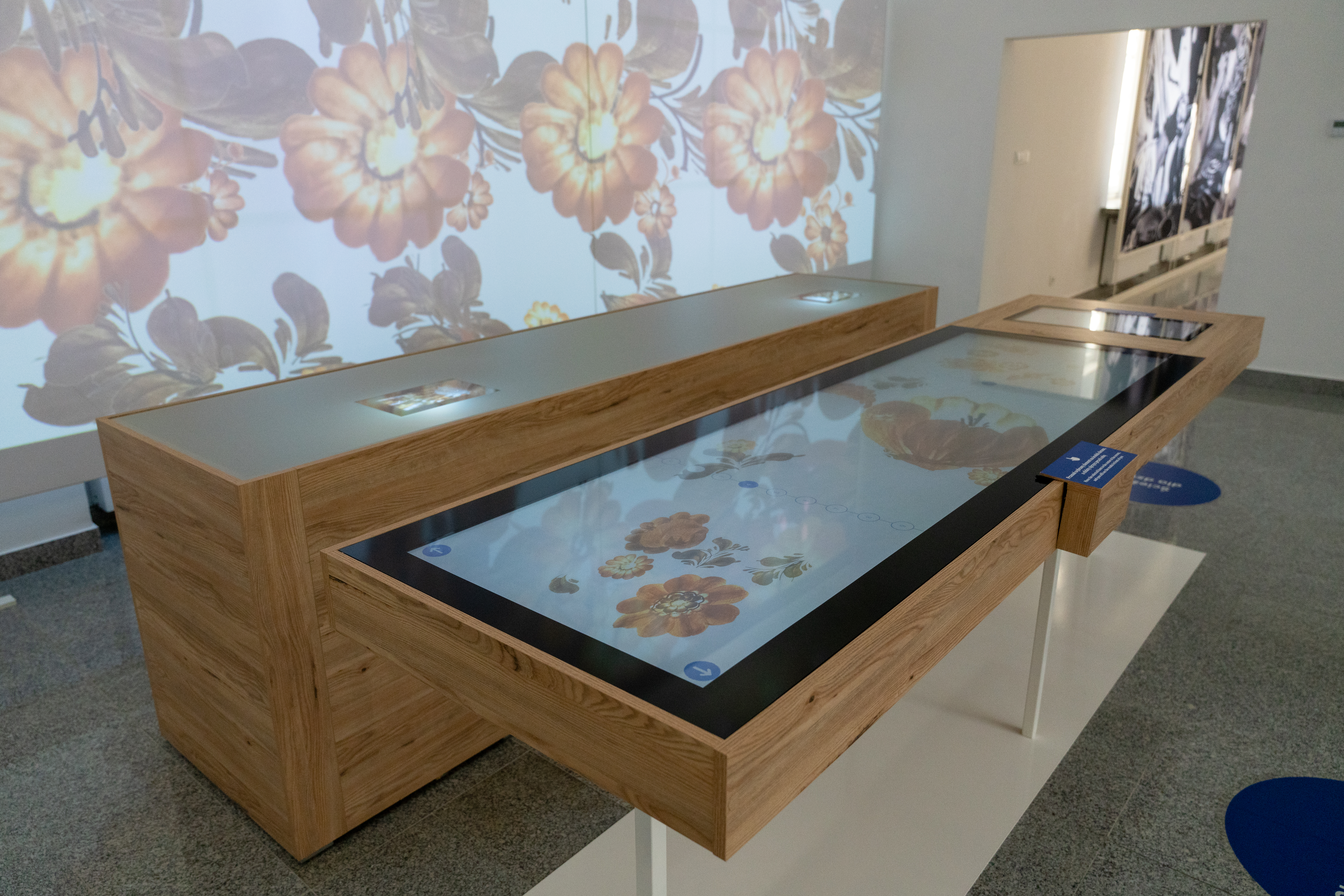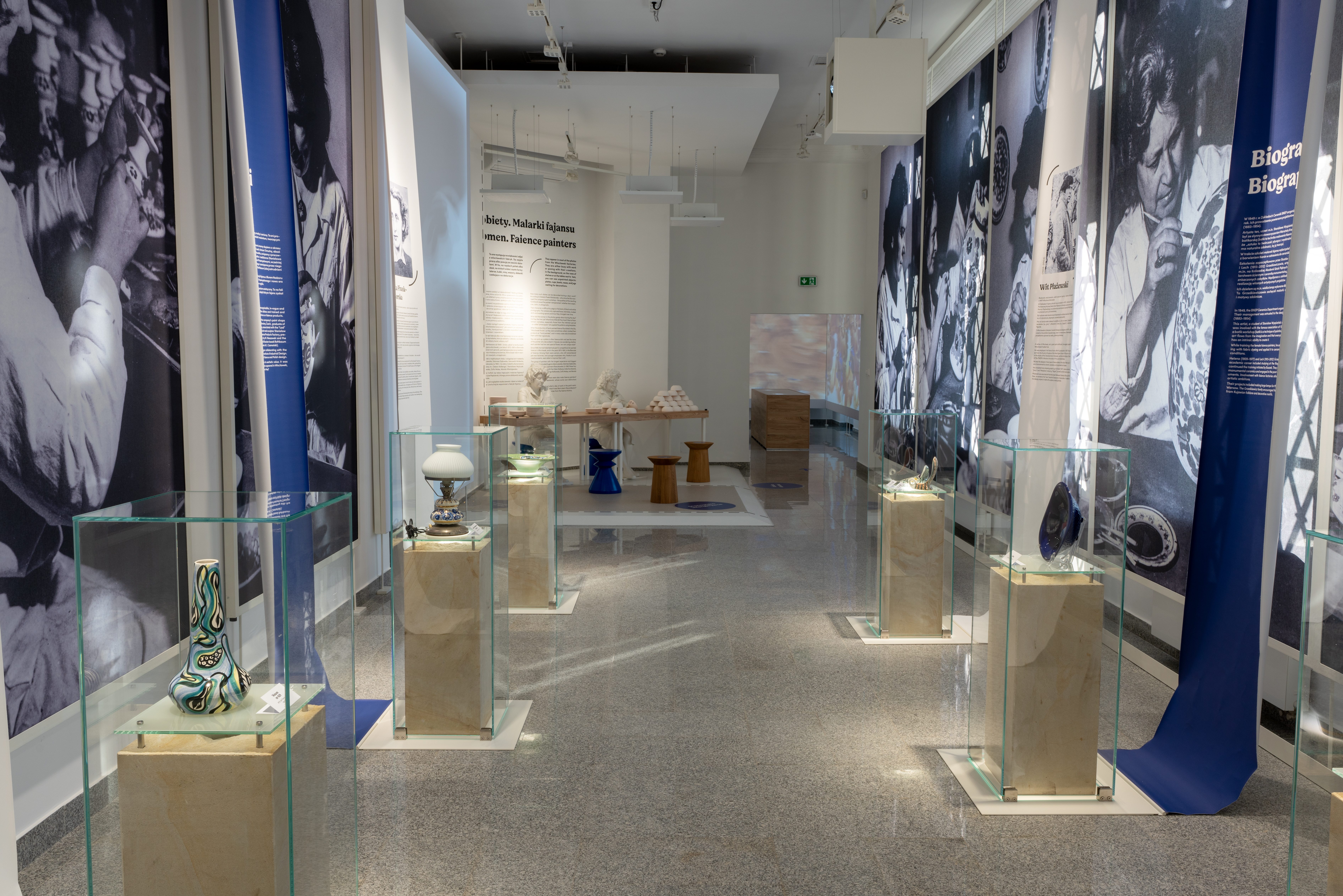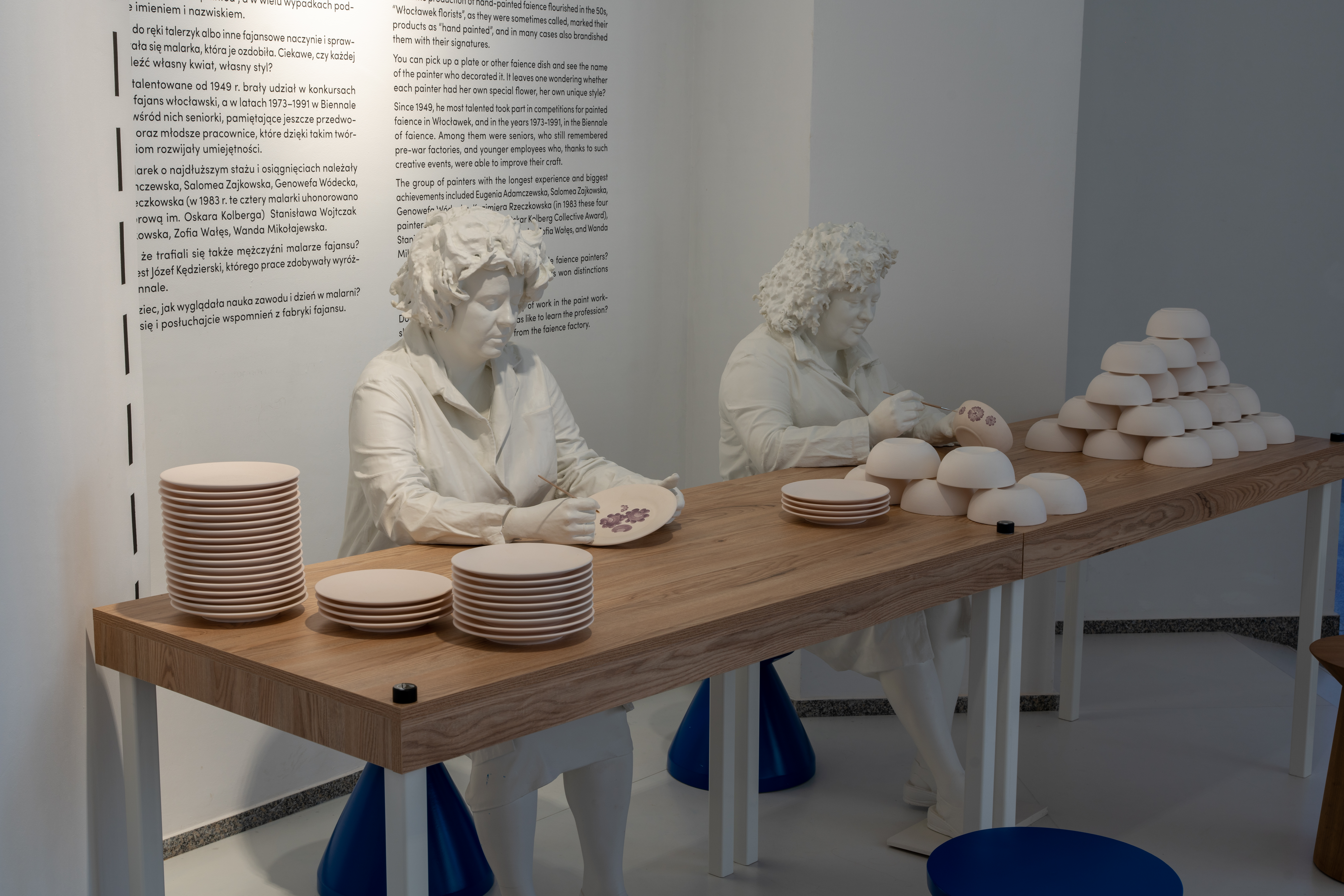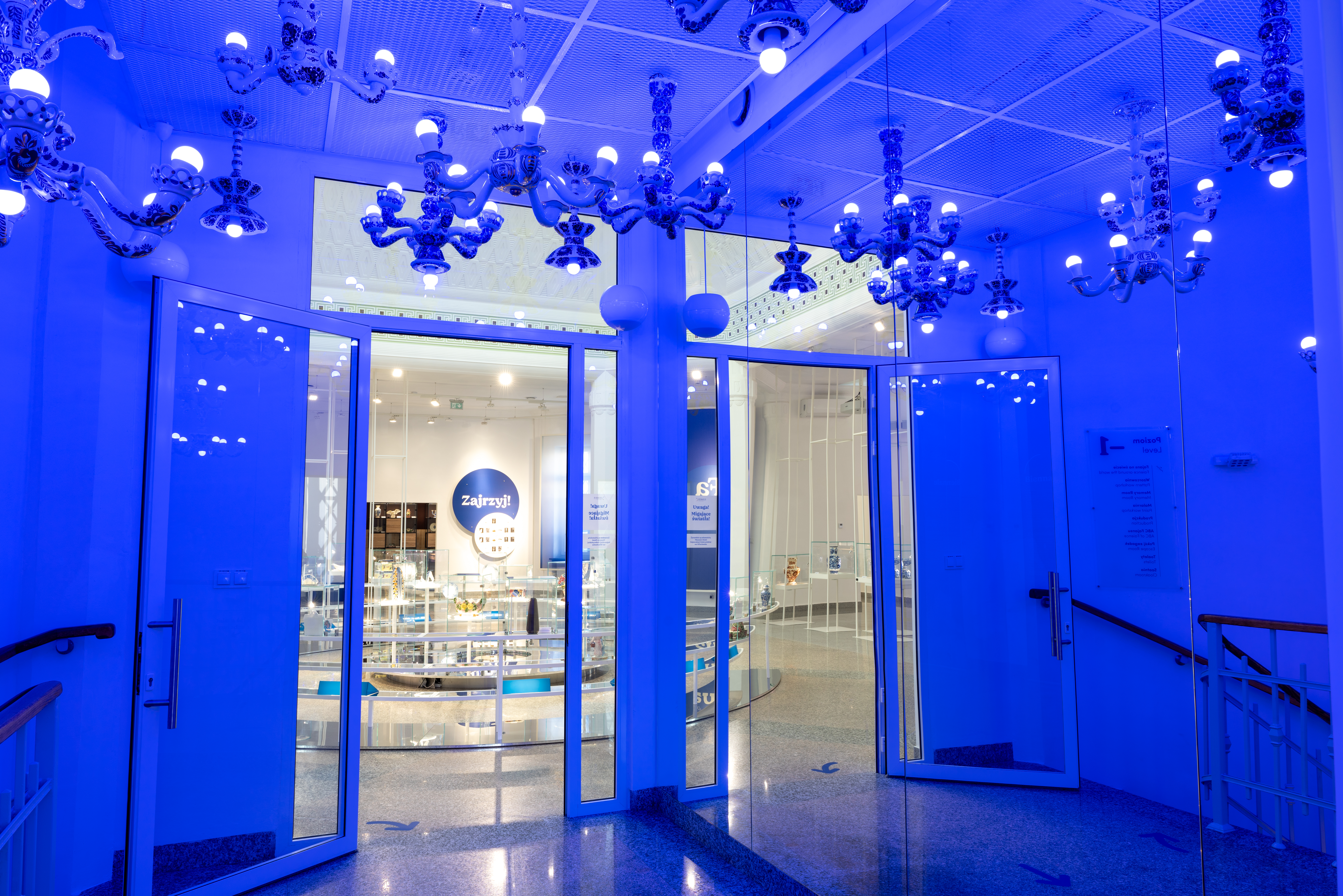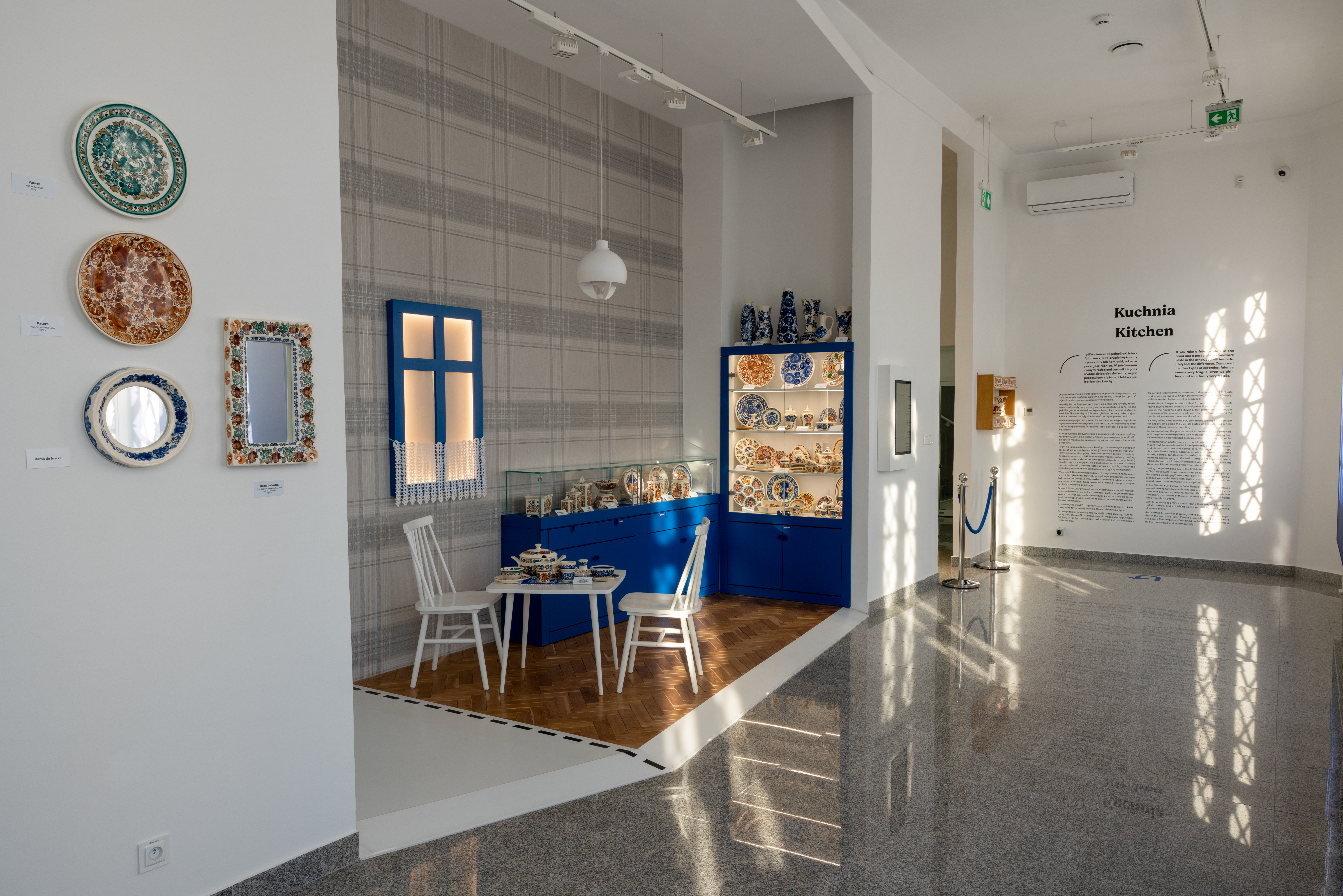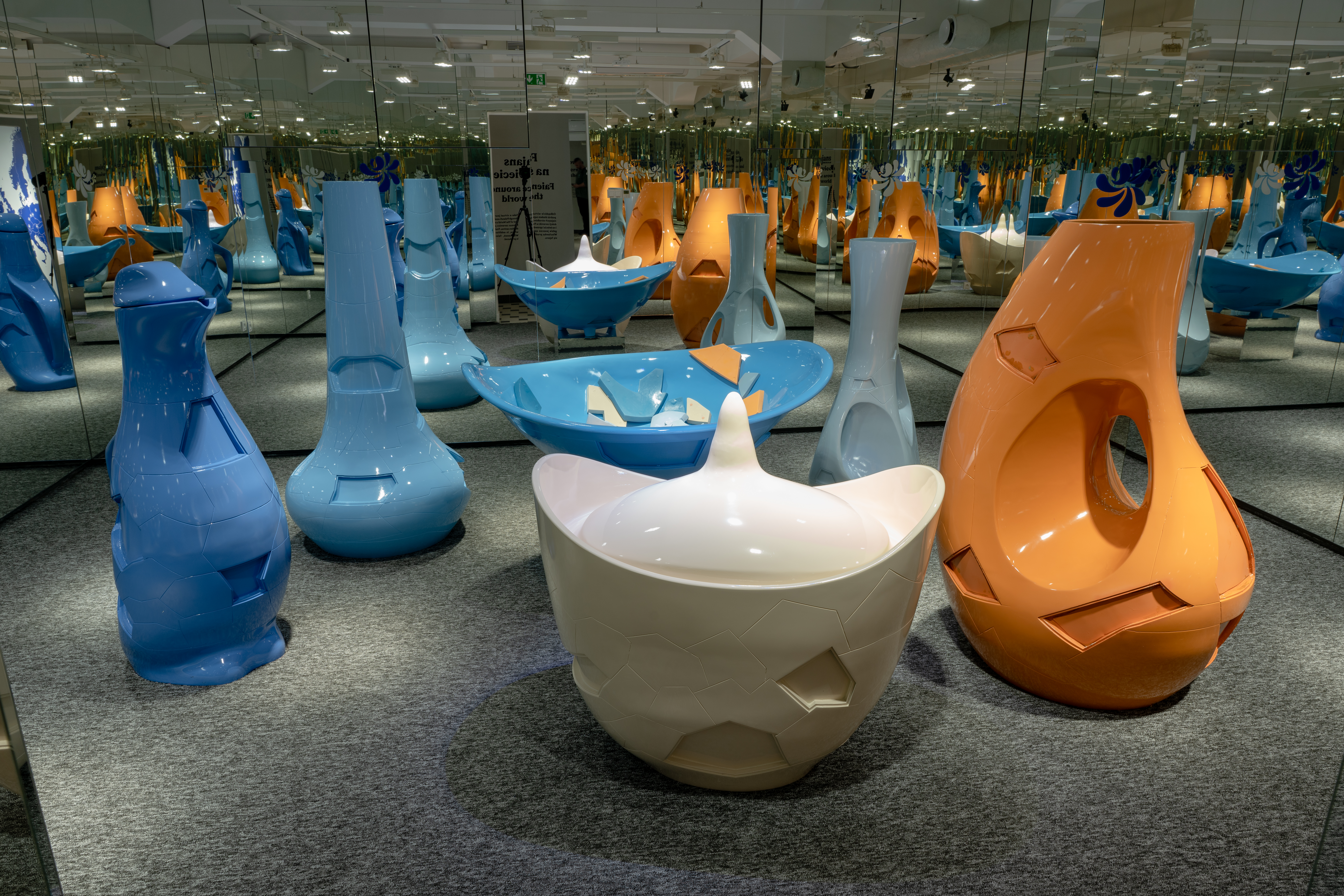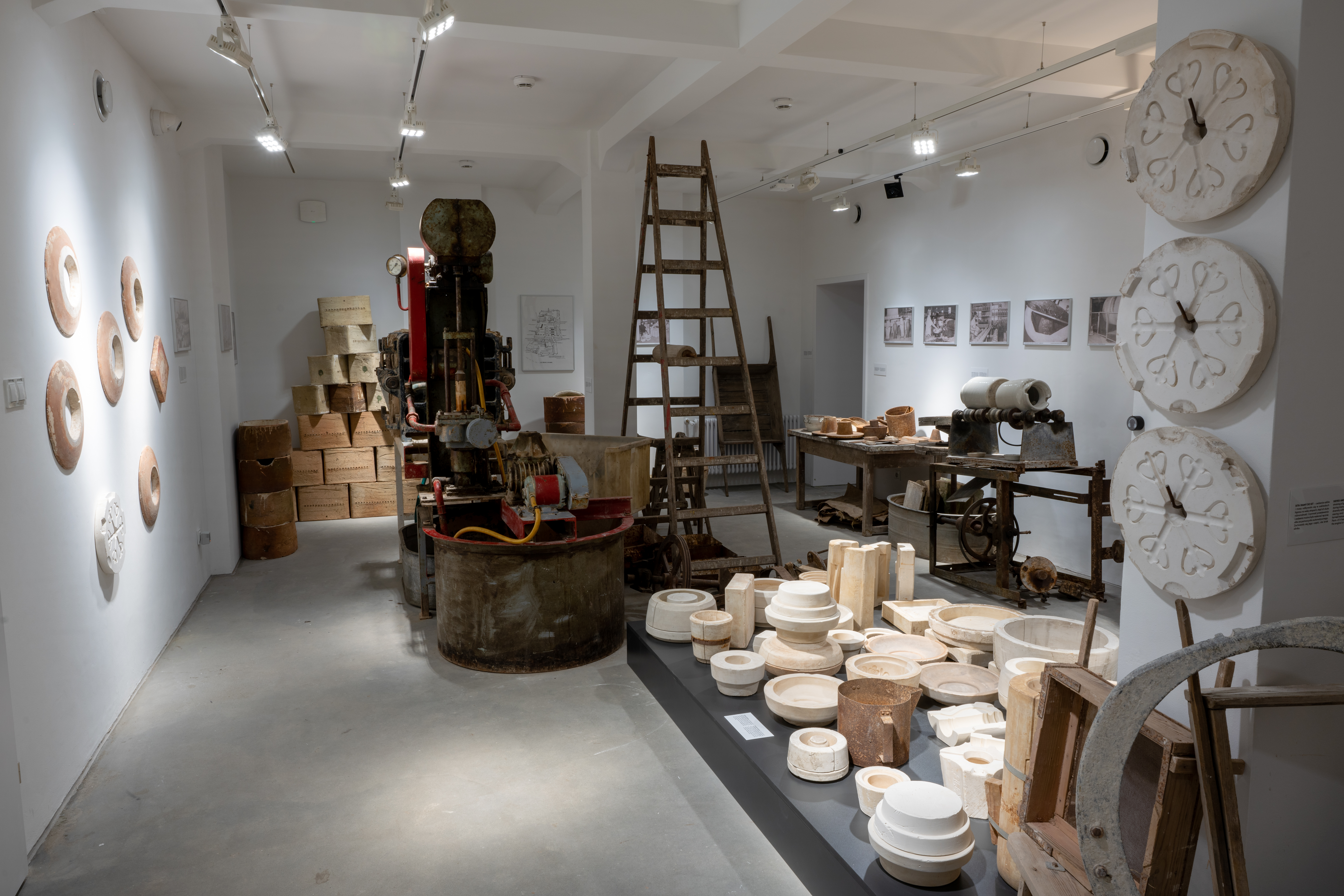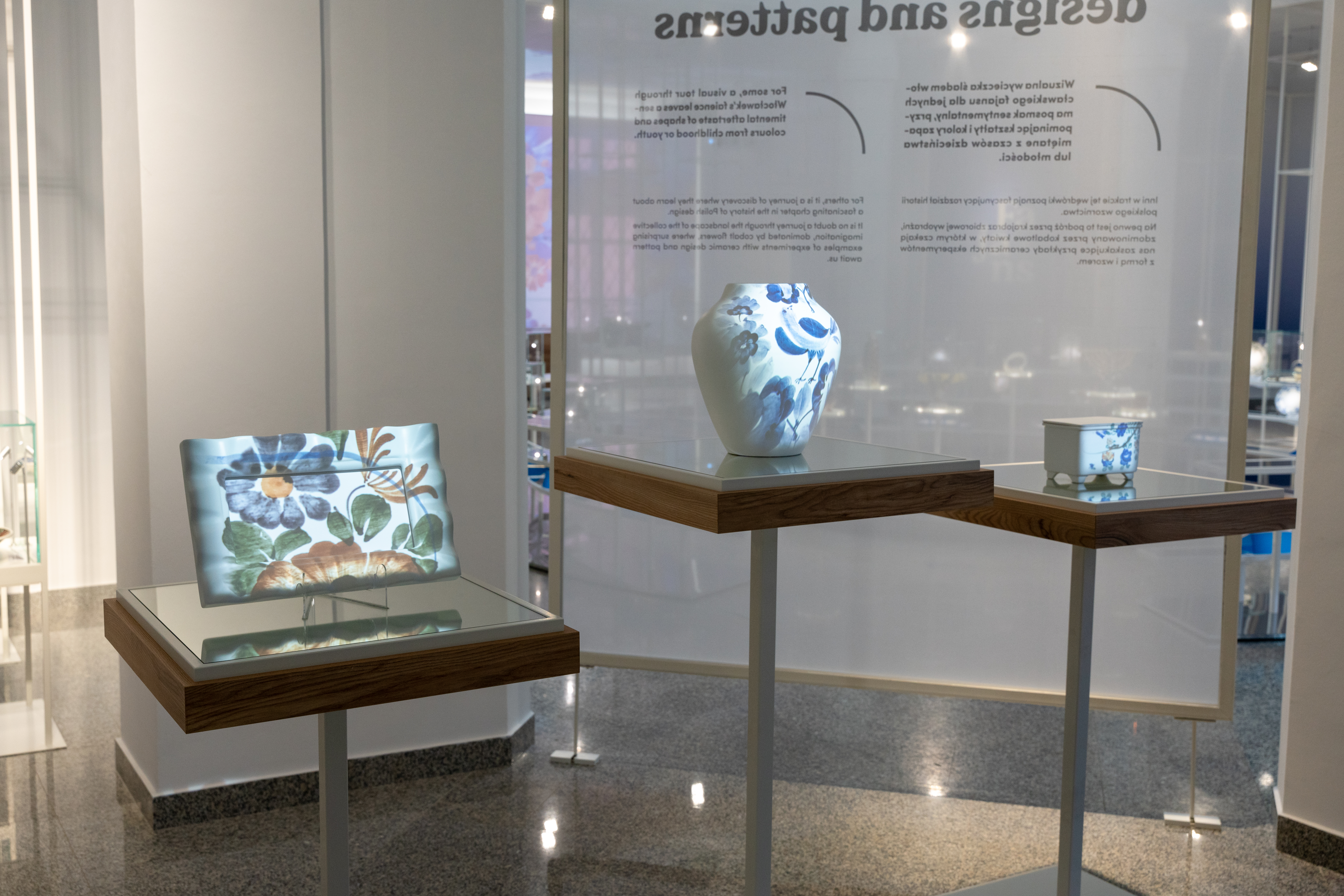Regaining a sense of belonging
Skarbiec Fajansu
Interactive Centre of Faience - Skarbiec Fajansu
The Interactive Centre of Faience – Skarbiec Fajansu (a branch of "Browar B." Cultural Centre) is a place where the past meets modernity, and tradition comes alive. Embark on a fascinating journey into the world of ceramics and explore the 150-year-old history of faience from Włocławek.
Thanks to the interactive spaces, which are adjusted to the age of the visitors, you can easily familiarize yourself with the rich history of ceramics from Włocławek.
Thanks to the interactive spaces, which are adjusted to the age of the visitors, you can easily familiarize yourself with the rich history of ceramics from Włocławek.
Poland
Regional
Kuyavian-Pomeranian Voivodship
Mainly urban
It refers to a physical transformation of the built environment (hard investment)
Yes
2023-09-29
Yes
ERDF : European Regional Development Fund
No
No
As a representative of an organisation
The project aimed to establish the Skarbiec Fajansu in Włocławek, in a socially degraded district of the city centre. It has been operating since September 29th, 2023, and has become one of the main tourist attractions in Włocławek. One of the project’s objectives was to revitalize tourism in the city, thereby increasing interest in its historical infrastructure and activities among both residents and visitors.
The Skarbiec Fajansu is dedicated to preserving and promoting the history and traditions associated with Włocławek faience. The origins of faience production date back to 1873. At its peak, the factory employed around 2,000 people. There was hardly a family in Włocławek without someone working in the factory. A vocational school for future decorators was also established. The products stood out due to their handmade nature. However, due to political and economic transformations, the factory was eventually closed. Despite this, faience remained deeply rooted in the collective memory of the city’s inhabitants.
The creation of the Skarbiec has had a profoundly positive impact on the local community. It was an important event that not only restored the former glory of local tradition but also strengthened the residents' sense of belonging to the cultural heritage. This unique place serves as a bridge connecting the past, present, and future of the city, allowing for both reflection on history and active participation in its continuation.
For older residents the Skarbiec has become a space for reminiscing. They can relive moments from their work in the factory, view exhibits showcasing patterns they once painted, and share their experiences with younger generations. This opportunity provides them with a sense of recognition for their efforts and contributions to the development of local craftsmanship while also strengthening intergenerational bonds.
For younger residents, the Skarbiec Fajansu serves as an invaluable lesson of the local history and culture.
The Skarbiec Fajansu is dedicated to preserving and promoting the history and traditions associated with Włocławek faience. The origins of faience production date back to 1873. At its peak, the factory employed around 2,000 people. There was hardly a family in Włocławek without someone working in the factory. A vocational school for future decorators was also established. The products stood out due to their handmade nature. However, due to political and economic transformations, the factory was eventually closed. Despite this, faience remained deeply rooted in the collective memory of the city’s inhabitants.
The creation of the Skarbiec has had a profoundly positive impact on the local community. It was an important event that not only restored the former glory of local tradition but also strengthened the residents' sense of belonging to the cultural heritage. This unique place serves as a bridge connecting the past, present, and future of the city, allowing for both reflection on history and active participation in its continuation.
For older residents the Skarbiec has become a space for reminiscing. They can relive moments from their work in the factory, view exhibits showcasing patterns they once painted, and share their experiences with younger generations. This opportunity provides them with a sense of recognition for their efforts and contributions to the development of local craftsmanship while also strengthening intergenerational bonds.
For younger residents, the Skarbiec Fajansu serves as an invaluable lesson of the local history and culture.
Faience
Education
Ceramics
Heritage
Modernity
The project incorporates environmentally friendly solutions and adheres to the principles of sustainability. Two retention tanks with capacities of 7.0 m³ and 6.0 m³ have been installed to manage rainwater efficiently. The retained water is discharged into the drainage system through two stormwater pumping stations, ensuring controlled and sustainable water management. Additionally, part of the rainwater collected from the roof of the historic section of the building is directed onto the investor's property, reducing runoff impact.
To enhance natural water retention, permeable surfaces have been introduced, replacing previously hardened areas around the building. This approach allows rainwater to infiltrate the ground, reducing the burden on the drainage system.
Furthermore, the building is equipped with a photovoltaic installation with a capacity of 6.93 kW, contributing to renewable energy generation and reducing the project's carbon footprint.
By integrating these solutions, the project serves as a model of sustainable architecture, demonstrating innovative approaches to water management, energy efficiency, and ecological responsibility.
To enhance natural water retention, permeable surfaces have been introduced, replacing previously hardened areas around the building. This approach allows rainwater to infiltrate the ground, reducing the burden on the drainage system.
Furthermore, the building is equipped with a photovoltaic installation with a capacity of 6.93 kW, contributing to renewable energy generation and reducing the project's carbon footprint.
By integrating these solutions, the project serves as a model of sustainable architecture, demonstrating innovative approaches to water management, energy efficiency, and ecological responsibility.
Visitors particularly appreciate the interactive nature of the Skarbiec Fajansu, which sets it apart from other attractions in Włocławek and the region. They respond positively to the departure from the traditional museum concept, where exhibits can only be viewed without being touched. They highlight the modernity and careful design of the space, whose appeal ensures that everyone finds something of interest – both in terms of entertainment and historical knowledge.
The Skarbiec Fajansu changes the perception of faience as local heritage. Thanks to innovative exhibit presentation methods, visitors recognize not only their practical function but also its artistic value, such as unique patterns, hand-painted decorations, and its popularity across the country. As a result, awareness of faience history and its production in Włocławek increases. Visitors can learn about the history of local factories in an accessible way, contributing to a broader understanding of the city and the region.
A special attractions for children are the interactive elements of the exhibition – they eagerly engage in activities that allow them to touch, open, and listen to various content. They spend most time on level -1, where a dedicated entertainment area has been prepared for them. Thanks to a well-designed visitor path, every room offers something engaging for the youngest guests.
Adults, on the other hand, focus primarily on historical aspects and the faience products. Visitors often emphasize that the exhibition evokes a sense of nostalgia and brings back memories from their youth.
The Skarbiec Fajansu changes the perception of faience as local heritage. Thanks to innovative exhibit presentation methods, visitors recognize not only their practical function but also its artistic value, such as unique patterns, hand-painted decorations, and its popularity across the country. As a result, awareness of faience history and its production in Włocławek increases. Visitors can learn about the history of local factories in an accessible way, contributing to a broader understanding of the city and the region.
A special attractions for children are the interactive elements of the exhibition – they eagerly engage in activities that allow them to touch, open, and listen to various content. They spend most time on level -1, where a dedicated entertainment area has been prepared for them. Thanks to a well-designed visitor path, every room offers something engaging for the youngest guests.
Adults, on the other hand, focus primarily on historical aspects and the faience products. Visitors often emphasize that the exhibition evokes a sense of nostalgia and brings back memories from their youth.
The key objectives of the Skarbiec Fajansu project regarding inclusivity focus on ensuring access and participation opportunities for every social group, regardless of age, ability, or cultural background. This approach makes it an open space where everyone can explore and co-create local heritage.
One of the project's priorities is eliminating architectural and technological barriers to ensure accessibility for individuals with various disabilities. To achieve this, the space has been designed to provide access to all areas of the building through ramps and lifts, as well as offering educational materials in audio and written forms.
The Skarbiec Fajansu aims to bridge generational gaps – older residents, who have personal memories related to the faience factory, can share their knowledge and experiences with younger generations.
The project seeks to engage individuals from socially vulnerable groups in educational and artistic activities, including elderly people and youth.
The Skarbiec’s program of workshops and events is adjusted to individuals with different skill levels. Whether someone has never held a paintbrush or is an experienced artist, they will find a space to develop their passions. Special emphasis is placed on equalizing educational opportunities for children and young people from less privileged backgrounds.
Inclusivity within the project also extends to engaging the residents of Włocławek in its creation and development. Many of the activities held at the Skarbiec are organized with the participation of local artists, craftsmen, and former factory workers. Residents can actively contribute to designing workshops, creating exhibitions, and organizing events.
Striving for economic inclusivity, the project offers affordable, and occasionally free, admission to exhibitions and workshops. This ensures that financial constraints do not prevent anyone from experiencing culture and art. The pricing structure also includes various discounts.
One of the project's priorities is eliminating architectural and technological barriers to ensure accessibility for individuals with various disabilities. To achieve this, the space has been designed to provide access to all areas of the building through ramps and lifts, as well as offering educational materials in audio and written forms.
The Skarbiec Fajansu aims to bridge generational gaps – older residents, who have personal memories related to the faience factory, can share their knowledge and experiences with younger generations.
The project seeks to engage individuals from socially vulnerable groups in educational and artistic activities, including elderly people and youth.
The Skarbiec’s program of workshops and events is adjusted to individuals with different skill levels. Whether someone has never held a paintbrush or is an experienced artist, they will find a space to develop their passions. Special emphasis is placed on equalizing educational opportunities for children and young people from less privileged backgrounds.
Inclusivity within the project also extends to engaging the residents of Włocławek in its creation and development. Many of the activities held at the Skarbiec are organized with the participation of local artists, craftsmen, and former factory workers. Residents can actively contribute to designing workshops, creating exhibitions, and organizing events.
Striving for economic inclusivity, the project offers affordable, and occasionally free, admission to exhibitions and workshops. This ensures that financial constraints do not prevent anyone from experiencing culture and art. The pricing structure also includes various discounts.
The engagement of residents and society in the implementation of the Skarbiec Fajansu was key to its success. From the planning stage, public consultations were organized, during which residents shared ideas and feedback. Social needs were heard, former factory workers were involved, providing knowledge about the tradition and history of faience, and target groups such as elderly people, youth, and people with disabilities were identified. As a result, the project meets the real expectations of the local community.
Residents played a crucial role in co-creating the content of the Skarbiec. They contributed memorabilia, memories, and accounts that enriched the exhibition. The local artistic community participated in creating exhibitions and workshops, allowing the fusion of tradition with a modern approach. As a result, the content presented in the Skarbiec is authentic and deeply connected to the emotions of the residents.
After its opening, citizens actively participate in workshops such as clay sculpting and faience painting, as well as cultural events. Additionally, the Skarbiec cooperates with non-governmental organizations that have supported, among other things, accessibility for people with disabilities and the implementation of educational programs.
This engagement has contributed to the project's success, making the Skarbiec a vibrant and inclusive place for everyone. Residents felt like co-creators of this initiative, which strengthened community integration and increased pride in the faience heritage. The Skarbiec has become not only an exhibition space but also a symbol of community and shared responsibility for the region’s culture.
Residents played a crucial role in co-creating the content of the Skarbiec. They contributed memorabilia, memories, and accounts that enriched the exhibition. The local artistic community participated in creating exhibitions and workshops, allowing the fusion of tradition with a modern approach. As a result, the content presented in the Skarbiec is authentic and deeply connected to the emotions of the residents.
After its opening, citizens actively participate in workshops such as clay sculpting and faience painting, as well as cultural events. Additionally, the Skarbiec cooperates with non-governmental organizations that have supported, among other things, accessibility for people with disabilities and the implementation of educational programs.
This engagement has contributed to the project's success, making the Skarbiec a vibrant and inclusive place for everyone. Residents felt like co-creators of this initiative, which strengthened community integration and increased pride in the faience heritage. The Skarbiec has become not only an exhibition space but also a symbol of community and shared responsibility for the region’s culture.
In the process of preparing the substantive concept for the operation of the Skarbiec Fajansu and its implementation, several institutions were involved: the "Browar B." Cultural Center (at that stage, it was not yet known that the Skarbiec would become a branch of the Cultural Center in the future), the Museum of the Kuyavian and Dobrzyń Region, and the Polish Tourist and Sightseeing Society. The participation of these institutions in developing the concept of the Skarbiec Fajansu was crucial for creating an attractive and educational space that would combine tradition with modernity.
The "Browar B." Cultural Center, as the biggest municipal cultural institution, took on the responsibility of developing and coordinating the implementation of the Skarbiec Fajansu project. Its employees participated in the development of educational content, workshops, and equipment selection. They also consulted on staffing needs and general operational issues of the facility.
The Museum, which has a Faience Department within its structure, possesses extensive knowledge about the history of faience, its production, cultural significance, and local traditions associated with this craft. Collaboration with the museum in developing the concept allowed for the inclusion of comprehensive information on faience, forming the substantive foundation of the project. Additionally, the institution lends exhibits covering the entire history of Włocławek ceramics.
Local tourist guides contributed their knowledge regarding visitors’ expectations, preferences, and potential challenges during sightseeing. Their insights and experiences helped design a space that is both comfortable and appealing to visitors.
The "Browar B." Cultural Center, as the biggest municipal cultural institution, took on the responsibility of developing and coordinating the implementation of the Skarbiec Fajansu project. Its employees participated in the development of educational content, workshops, and equipment selection. They also consulted on staffing needs and general operational issues of the facility.
The Museum, which has a Faience Department within its structure, possesses extensive knowledge about the history of faience, its production, cultural significance, and local traditions associated with this craft. Collaboration with the museum in developing the concept allowed for the inclusion of comprehensive information on faience, forming the substantive foundation of the project. Additionally, the institution lends exhibits covering the entire history of Włocławek ceramics.
Local tourist guides contributed their knowledge regarding visitors’ expectations, preferences, and potential challenges during sightseeing. Their insights and experiences helped design a space that is both comfortable and appealing to visitors.
The primary field considered in the design of the Skarbiec Fajansu was ceramics. It is the foundation of faience production. The project involved sculptors – Antoni Bisaga and Janusz Bisaga.
After completing his studies in 1966, Antoni Bisaga settled in Włocławek. He worked at the Włocławek Tableware Factory as a designer at the Pattern Centre. He designed numerous service sets, plates, vases, candlesticks, and chandeliers. Antoni Bisaga hosts occasional workshops at the Skarbiec.
Together with his son, Janusz Bisaga, he saved part of the factory’s equipment from destruction, which can now be seen in the Skarbiec.
Janusz Bisaga is a sculptor who creates ceramic compositions, sculptures for churches, interiors, and gardens, as well as mosaics. During his childhood and youth, the faience factory was his second home. He knows the technology and history of the plant inside out. At the Skarbiec Fajansu, he currently works as the Manager of Education and Exhibitions.
The participation of sculptors in the creation of the Skarbiec Fajansu was crucial, both in the design stage and in shaping a space that not only showcases Włocławek’s faience heritage but also evokes emotions and inspires people to discover local traditions in a new way. Their contribution went beyond aesthetic considerations – sculptors also brought their artistic sensitivity and the ability to give Włocławek’s history and culture a contemporary form of expression.
Former painters from the Włocławek Tableware Factory also took part in the project. Their memories were recorded and can be heard while touring the exhibition. This brings the history of the factory to life, told not by silent witnesses of those years but by the women who once worked in the painting rooms.
Thanks to the involvement of sculptors and painters, the Skarbiec Fajansu has become not only a place documenting history but also an artistic space that actively promotes and develops Włocławek’s faience tradition.
After completing his studies in 1966, Antoni Bisaga settled in Włocławek. He worked at the Włocławek Tableware Factory as a designer at the Pattern Centre. He designed numerous service sets, plates, vases, candlesticks, and chandeliers. Antoni Bisaga hosts occasional workshops at the Skarbiec.
Together with his son, Janusz Bisaga, he saved part of the factory’s equipment from destruction, which can now be seen in the Skarbiec.
Janusz Bisaga is a sculptor who creates ceramic compositions, sculptures for churches, interiors, and gardens, as well as mosaics. During his childhood and youth, the faience factory was his second home. He knows the technology and history of the plant inside out. At the Skarbiec Fajansu, he currently works as the Manager of Education and Exhibitions.
The participation of sculptors in the creation of the Skarbiec Fajansu was crucial, both in the design stage and in shaping a space that not only showcases Włocławek’s faience heritage but also evokes emotions and inspires people to discover local traditions in a new way. Their contribution went beyond aesthetic considerations – sculptors also brought their artistic sensitivity and the ability to give Włocławek’s history and culture a contemporary form of expression.
Former painters from the Włocławek Tableware Factory also took part in the project. Their memories were recorded and can be heard while touring the exhibition. This brings the history of the factory to life, told not by silent witnesses of those years but by the women who once worked in the painting rooms.
Thanks to the involvement of sculptors and painters, the Skarbiec Fajansu has become not only a place documenting history but also an artistic space that actively promotes and develops Włocławek’s faience tradition.
The Skarbiec Fajansu stands out for its innovative approach to cultural heritage preservation, seamlessly blending tradition with modernity and engaging the local community in a way that is rarely seen in traditional cultural institutions.
Unlike typical museums, the Skarbiec doesn't merely showcase faience products; it uses modern technologies such as interactive screens or light and sound projections, allowing visitors to explore the history of faience in an engaging way. Through multimedia presentations, younger generations can understand and appreciate tradition using communication methods tailored to their expectations. Some exhibits are at their fingertips.
The Skarbiec offers a unique experience by enabling participants to learn traditional ceramic techniques and faience painting through workshops. This approach transforms heritage into a living practice rather than just an exhibit behind glass. The hands-on educational dimension allows both locals and tourists to actively participate in preserving tradition. Live demonstrations of faience pattern painting are frequently organized, featuring painters from the former faience factory. Visitors can witness the creation of faience designs firsthand and even sit at a table to try this challenging craft themselves.
The project involved the residents of Włocławek, including former faience factory employees, artists, and craftsmen who contributed memorabilia, memories, and knowledge. Co-creating the exhibition and activity program has made the Skarbiec a shared space for the local community, fostering identity and a sense of belonging.
Workshops and training sessions support the local economy by promoting craftsmanship as an alternative source of income. The Skarbiec inspires residents to develop their own craft-related initiatives, bridging tradition with entrepreneurship.
Unlike typical museums, the Skarbiec doesn't merely showcase faience products; it uses modern technologies such as interactive screens or light and sound projections, allowing visitors to explore the history of faience in an engaging way. Through multimedia presentations, younger generations can understand and appreciate tradition using communication methods tailored to their expectations. Some exhibits are at their fingertips.
The Skarbiec offers a unique experience by enabling participants to learn traditional ceramic techniques and faience painting through workshops. This approach transforms heritage into a living practice rather than just an exhibit behind glass. The hands-on educational dimension allows both locals and tourists to actively participate in preserving tradition. Live demonstrations of faience pattern painting are frequently organized, featuring painters from the former faience factory. Visitors can witness the creation of faience designs firsthand and even sit at a table to try this challenging craft themselves.
The project involved the residents of Włocławek, including former faience factory employees, artists, and craftsmen who contributed memorabilia, memories, and knowledge. Co-creating the exhibition and activity program has made the Skarbiec a shared space for the local community, fostering identity and a sense of belonging.
Workshops and training sessions support the local economy by promoting craftsmanship as an alternative source of income. The Skarbiec inspires residents to develop their own craft-related initiatives, bridging tradition with entrepreneurship.
The Skarbiec Fajansu was implemented using a comprehensive approach that combined public consultations, co-creation with residents, the integration of diverse social groups, and the use of modern tools. The project’s methodology focused on four key pillars: community participation, an innovative approach to cultural heritage, inclusivity, and hands-on education.
At an early stage, public consultations were conducted to understand the needs and expectations of local residents. Meetings with the community, former faience factory workers, and local artists provided valuable insights and ideas. This process ensured that the project was tailored to the reality of Włocławek, increasing public acceptance and engagement.
Memories, photographs, faience products, and stories related to the old factory were collected. Collaboration with local artists allowed for a fresh and modern presentation of faience traditions.
The project incorporated modern tools such as interactive screens, virtual audiovisual projections, and audio guides to make the faience history more engaging. This approach made the storytelling more dynamic and suited to contemporary audiences, particularly younger generations.
A key objective was to create a space for hands-on learning about faience heritage. Ceramic and faience painting workshops, organized as part of the Skarbiec’s educational program, allow participants to develop new skills and experience traditional techniques firsthand. This approach combines education with active participation, strengthening the connection to local heritage.
The project’s methodology prioritized accessibility for various social groups. The space was designed to be inclusive for people with disabilities, and the event program addressed the needs of different age groups, from children to older people.
The implementation of the Skarbiec Fajansu was based on social integration, an innovative approach to heritage, and hands-on education.
At an early stage, public consultations were conducted to understand the needs and expectations of local residents. Meetings with the community, former faience factory workers, and local artists provided valuable insights and ideas. This process ensured that the project was tailored to the reality of Włocławek, increasing public acceptance and engagement.
Memories, photographs, faience products, and stories related to the old factory were collected. Collaboration with local artists allowed for a fresh and modern presentation of faience traditions.
The project incorporated modern tools such as interactive screens, virtual audiovisual projections, and audio guides to make the faience history more engaging. This approach made the storytelling more dynamic and suited to contemporary audiences, particularly younger generations.
A key objective was to create a space for hands-on learning about faience heritage. Ceramic and faience painting workshops, organized as part of the Skarbiec’s educational program, allow participants to develop new skills and experience traditional techniques firsthand. This approach combines education with active participation, strengthening the connection to local heritage.
The project’s methodology prioritized accessibility for various social groups. The space was designed to be inclusive for people with disabilities, and the event program addressed the needs of different age groups, from children to older people.
The implementation of the Skarbiec Fajansu was based on social integration, an innovative approach to heritage, and hands-on education.
The Skarbiec Fajansu project includes many universal elements that can be transferred or replicated in other locations, beneficiary groups, or contexts. Its versatility and innovation make the applied solutions an inspiration for activities related to the protection and promotion of cultural heritage in various regions.
Interactive tools, such as multimedia exhibitions or audio guides, can be adapted to promote other local history and traditions. These technologies are universal and allow for an engaging presentation of diverse topics, making them more accessible to younger generations and tourists.
Practical workshops, such as pottery or painting faience, present a scalable model that can be replicated in other fields, such as weaving or painting workshops. Hands-on education enables participants to engage more deeply with heritage and fosters an emotional connection with local culture.
The inclusive solutions implemented in the Skarbiec – from adapting spaces for people with disabilities to intergenerational integration – can be applied to other cultural projects. A universal accessibility model allows for the creation of open spaces for everyone, regardless of age or physical abilities.
The Skarbiec Fajansu combines heritage preservation with tourism promotion, which can be adapted elsewhere. Utilizing local traditions as the foundation for tourism activities supports the economy and strengthens the region’s brand, making it a universal development model.
Key project elements – collaboration with residents, interactive technologies, practical workshops, and an inclusivity model – can be successfully replicated in various places and contexts. The Skarbiec Fajansu serves as an example of how local heritage can be innovatively preserved, revitalized, and promoted while engaging the community and strengthening regional identity.
Interactive tools, such as multimedia exhibitions or audio guides, can be adapted to promote other local history and traditions. These technologies are universal and allow for an engaging presentation of diverse topics, making them more accessible to younger generations and tourists.
Practical workshops, such as pottery or painting faience, present a scalable model that can be replicated in other fields, such as weaving or painting workshops. Hands-on education enables participants to engage more deeply with heritage and fosters an emotional connection with local culture.
The inclusive solutions implemented in the Skarbiec – from adapting spaces for people with disabilities to intergenerational integration – can be applied to other cultural projects. A universal accessibility model allows for the creation of open spaces for everyone, regardless of age or physical abilities.
The Skarbiec Fajansu combines heritage preservation with tourism promotion, which can be adapted elsewhere. Utilizing local traditions as the foundation for tourism activities supports the economy and strengthens the region’s brand, making it a universal development model.
Key project elements – collaboration with residents, interactive technologies, practical workshops, and an inclusivity model – can be successfully replicated in various places and contexts. The Skarbiec Fajansu serves as an example of how local heritage can be innovatively preserved, revitalized, and promoted while engaging the community and strengthening regional identity.
The Skarbiec Fajansu project addresses several key global challenges, such as the protection of cultural heritage, social integration, counteracting exclusion, and the development of sustainable tourism. Through local initiatives, it offers practical solutions that can serve as an inspiration in a broader global context.
In an era of advancing globalization and cultural unification, one of the most significant challenges is preserving and promoting local heritage. The Skarbiec project responds to this challenge by documenting the 150-year-old history of Włocławek faience and actively engaging the community in maintaining this tradition. Through workshops, exhibitions, and education, the project not only preserves heritage but also gives it a modern dimension, demonstrating that local traditions can endure and evolve in changing global conditions.
A challenge faced by many societies is the integration of diverse social groups, including people with disabilities, older people, youth, and those at risk of exclusion. The Skarbiec Fajansu promotes inclusivity by creating an accessible space for everyone and developing programs that address the needs of various groups.
In response to the challenge of sustainable development, the Skarbiec Fajansu promotes local culture as a key element of tourism based on authentic experiences. Unlike mass tourism, the project focuses on heritage preservation and supporting local communities.
Education and the transmission of traditions to younger generations is a challenge in many societies where interest in local heritage is declining. The Skarbiec addresses this issue by organizing interactive workshops and educational activities that teach through hands-on experience and actively engage youth. After just over a year of operation, students from Włocławek schools independently approached the project, expressing their willingness to launch an initiative under its patronage to promote the tradition of Włocławek faience.
In an era of advancing globalization and cultural unification, one of the most significant challenges is preserving and promoting local heritage. The Skarbiec project responds to this challenge by documenting the 150-year-old history of Włocławek faience and actively engaging the community in maintaining this tradition. Through workshops, exhibitions, and education, the project not only preserves heritage but also gives it a modern dimension, demonstrating that local traditions can endure and evolve in changing global conditions.
A challenge faced by many societies is the integration of diverse social groups, including people with disabilities, older people, youth, and those at risk of exclusion. The Skarbiec Fajansu promotes inclusivity by creating an accessible space for everyone and developing programs that address the needs of various groups.
In response to the challenge of sustainable development, the Skarbiec Fajansu promotes local culture as a key element of tourism based on authentic experiences. Unlike mass tourism, the project focuses on heritage preservation and supporting local communities.
Education and the transmission of traditions to younger generations is a challenge in many societies where interest in local heritage is declining. The Skarbiec addresses this issue by organizing interactive workshops and educational activities that teach through hands-on experience and actively engage youth. After just over a year of operation, students from Włocławek schools independently approached the project, expressing their willingness to launch an initiative under its patronage to promote the tradition of Włocławek faience.
The implementation of the project has already led to visible transformations within the city. It is experiencing economic revitalization, evidenced by an increase in the number of businesses operating commercially in the ceramics industry. Currently, two factories are producing faience products. Additionally, other industries are drawing inspiration from and incorporating faience heritage into their work. This influence is reflected in clothing with faience motifs, jewellery made from faience shards, and various themed gadgets. These are also available in our gift shop.
The city authorities are increasingly embracing this unique cultural DNA, incorporating cobalt motifs into their logo and promotional materials. Large-scale faience vessels are also appearing in city spaces, emphasizing the its deep connection to faience traditions.
The project has also influenced how faience is perceived and adopted by well-established local brands. For example, Anwil Włocławek, a three-time Polish Basketball Champion, now plays in outfits featuring faience-inspired designs, created in collaboration with the Skarbiec Fajansu.
Another key outcome of the project is the creation of new jobs. Highly qualified individuals have found employment, contributing to the rich offerings of the Skarbiec Fajansu. A wide range of workshops attracts participants of all ages. Furthermore, community events such as “Noc w Skarbcu Fajansu” (“The night in Skarbiec Fajansu”) and competitions for students have proven to be highly popular, with impressive attendance rates.
As a result of the project, a historic bank building was saved. After deteriorating for many years, it was revitalized and given a new cultural and educational purpose. The institution has become a symbol of the city's identity, highlighting its unique artisanal tradition. Residents can once again take pride in their exceptional heritage, strengthening their sense of community and belonging.
The city authorities are increasingly embracing this unique cultural DNA, incorporating cobalt motifs into their logo and promotional materials. Large-scale faience vessels are also appearing in city spaces, emphasizing the its deep connection to faience traditions.
The project has also influenced how faience is perceived and adopted by well-established local brands. For example, Anwil Włocławek, a three-time Polish Basketball Champion, now plays in outfits featuring faience-inspired designs, created in collaboration with the Skarbiec Fajansu.
Another key outcome of the project is the creation of new jobs. Highly qualified individuals have found employment, contributing to the rich offerings of the Skarbiec Fajansu. A wide range of workshops attracts participants of all ages. Furthermore, community events such as “Noc w Skarbcu Fajansu” (“The night in Skarbiec Fajansu”) and competitions for students have proven to be highly popular, with impressive attendance rates.
As a result of the project, a historic bank building was saved. After deteriorating for many years, it was revitalized and given a new cultural and educational purpose. The institution has become a symbol of the city's identity, highlighting its unique artisanal tradition. Residents can once again take pride in their exceptional heritage, strengthening their sense of community and belonging.

